Domestic Violence Statistics 2024 – By Demographic, Advocate Industry, State and Abuse Rate
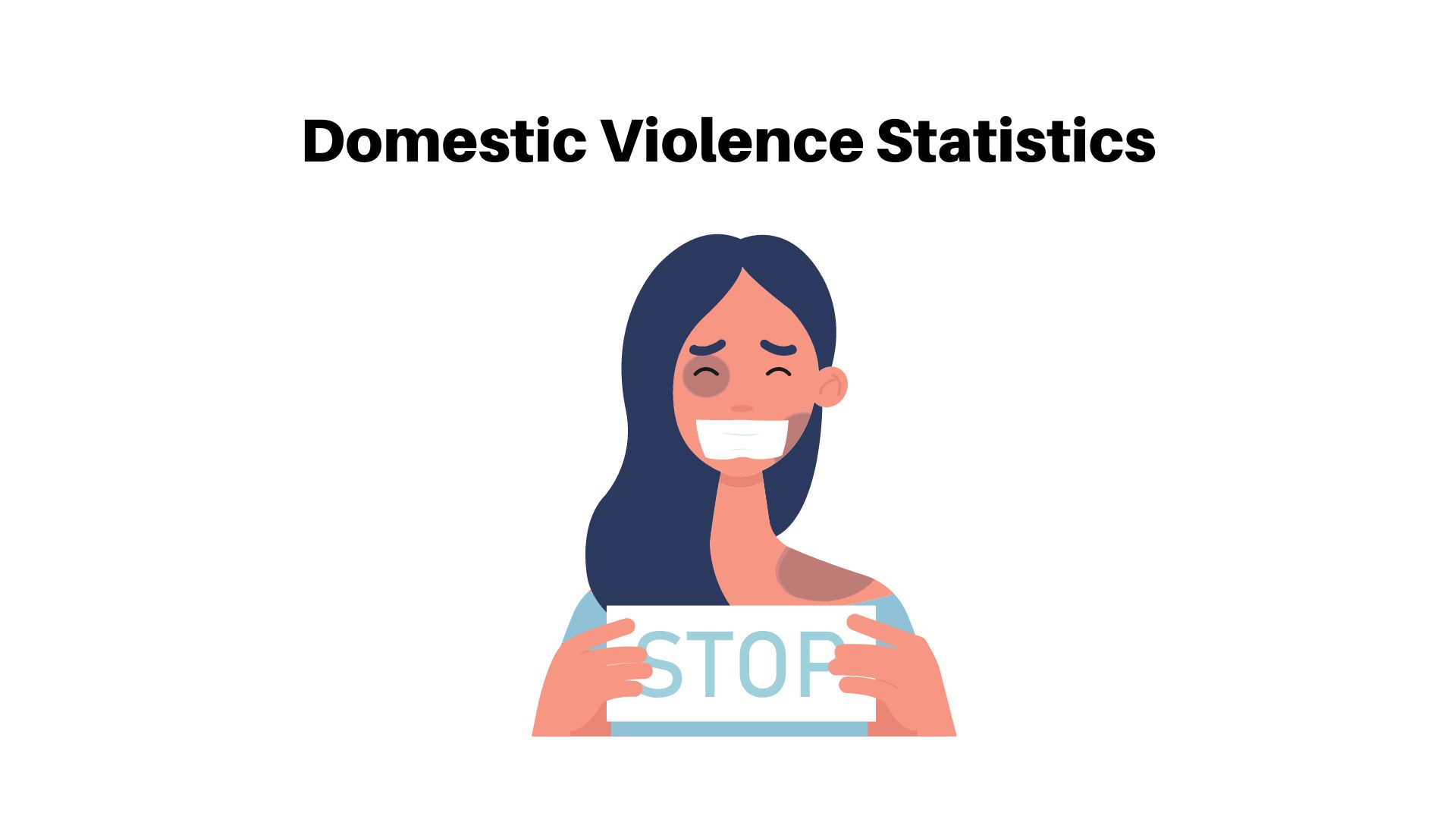
Page Contents
- Introduction
- Editor’s Choice
- Facts About Domestic Violence
- What Is Domestic Violence?
- Types Of Domestic Violence
- What causes domestic violence against women?
- General Domestic Violence Statistics
- Domestic Violence Statistics By Advocate Industry
- Statistical Domestic Violence By Demographic
- Domestic Violence Statistics By State
- Domestic Violence Statistics By Abuse Rate
- Important Domestic Violence Statistics for 2024
- Trends In Domestic Violence
- Recent Developments in Domestic Violence
- Conclusion
Introduction
Domestic Violence Statistics: Domestic violence statistics shed light on a significant societal issue affecting individuals and families worldwide. With millions of reported cases annually, this data serves as a critical resource for understanding the prevalence and impact of domestic violence on communities.
According to recent studies, domestic violence incidents cost the United States economy approximately USD 8.3 billion each year in medical expenses, legal costs, and lost productivity. Additionally, it is estimated that around 1 in 4 women and 1 in 9 men experience severe intimate partner physical violence, intimate partner contact sexual violence, and/or intimate partner stalking with impacts such as injury, fearfulness, post-traumatic stress disorder, use of victim services, contraction of sexually transmitted diseases, etc., each year.
examining domestic violence statistics is essential for identifying trends, assessing the effectiveness of intervention strategies, and advocating for policies aimed at prevention and support for survivors.
Editor’s Choice
- On average, 3 women and 1 man are killed by their intimate partners daily in the United States.
- Globally, 38% of women’s deaths result from murder by intimate partners.
- The lifetime economic cost of domestic violence by an intimate partner in the United States amounts to approximately USD 3.6 trillion.
- Annually, about 325,000 pregnant women face domestic abuse.
- Pregnant women experience the highest rate of domestic violence compared to other demographics.
- 45 million children witness family violence during their childhood.
- 44.2% of men and 47.3% of women have experienced domestic violence.
- 19.6% of women and 7.6% of men have experienced sexual violence from their intimate partner.
- 90% of children are direct eyewitnesses to family violence.
- 1 in 5 victims in homicide cases lost their lives to their intimate partner.
- Over 20,000 phone calls reporting domestic violence are made by U.S. residents annually.
- 93.1% of pregnant women experience intimate partner violence.
- 60% of children in the U.S. witness domestic abuse against a parent.
- 51.5% of multiracial men and 63.8% of multiracial women reported intimate partner violence in recent years.
- More than half of Congolese women have been raped by their intimate partners.
- Over one-third of domestically abused Americans are serious violence survivors.
- Battered U.S. women are 75% less likely to die when they don’t leave their abuser.
- American men are victims of domestic violence 12% of the time.
- Globally, 275 million children witness violence at home firsthand.
- Domestic violence support requests from Spanish women spiked by 700% in the first two weeks of April 2020.
- Nearly 1 in 3 women and 1 in 4 men in the U.S. will experience rape, physical violence, and/or stalking by an intimate partner in their lifetime.
- Almost 20 people are physically abused by an intimate partner each minute in the U.S.
- 1 in 4 women and 1 in 7 men have experienced severe physical violence by an intimate partner during their lifetime.
- Intimate partner violence accounts for 15% of all violent crimes.
- On a typical day, domestic violence hotlines receive more than 20,000 phone calls nationwide.
- Worldwide, 27% of women aged 15-49 report experiencing physical and/or sexual violence by their intimate partner.
- 47% of American Indian/Alaska Native women, 45.1% of non-Hispanic Black women, 37.3% of non-Hispanic White women, 34.4% of Hispanic women, and 18.3% of Asian-Pacific Islander women have experienced sexual violence, physical violence, and/or stalking by an intimate partner in their lifetime.
- Globally, intimate partners are responsible for as many as 38% of all murders of women.
- Women with disabilities have a 40% greater risk of intimate partner violence than women without disabilities.
- 53% of female violence survivors still involved with the perpetrator experienced self-blame.
- Approximately 63% of homeless women have experienced domestic violence.
- 20% of female high school students report being physically and/or sexually abused by an intimate partner.
- The lifetime economic cost of intimate partner violence to the U.S. population is estimated to be USD 3.6 trillion.
- On average, more than 3 women and 1 man are murdered by their intimate partners every day in the U.S
You May Also Like To Read
- Gun Violence Statistics
- Social Security Statistics
- Sexual Assault Statistics
- Human Trafficking Statistics
- Crime Statistics
- FBI Crime Statistics
- Referral Marketing Statistics
- Prison Statistics
- GDPR Statistics
- Piracy Statistics
- Notable Ransomware Statistics
- DDoS Statistics
- Divorce Statistics
Facts About Domestic Violence
- Worldwide, 27% of women aged 15-49 report experiencing physical and/or sexual violence by their intimate partner.
- 47% of American Indian/Alaska Native women, 45.1% of non-Hispanic Black women, 37.3% of non-Hispanic White women, 34.4% of Hispanic women, and 18.3% of Asian-Pacific Islander women have experienced sexual violence, physical violence, and/or stalking by an intimate partner in their lifetime.
- Globally, intimate partners are responsible for as many as 38% of all murders of women.
- Women with disabilities have a 40% greater risk of intimate partner violence than women without disabilities.
- 53% of female violence survivors still involved with the perpetrator experienced self-blame.
- Approximately 63% of homeless women have experienced domestic violence.
- Twenty percent of female high school students report being physically and/or sexually abused by an intimate partner.
What Is Domestic Violence?
Domestic violence Domestic abuse or family violence is various types of abuse or violence that mainly occurs in marital life or live-in relationships. These terms are always used with the word intimate partner violence, which could be a current partner or a former of any gender. Unfortunately, even today women are on the highest scale facing these problems in their life and yet they fail to report it.
Types Of Domestic Violence
- Emotional abuse – humiliating partner in public, harassing, destroying personality, threatening, not allowing to have basic needs, confiscating basic means of communication, continuous criticizing, insulting, ignoring partner’s feelings, etc…
- Physical abuse – throwing objects, spitting, biting, fights, murder, using weapons, strangling, pushing, scratching, slapping, punching and kicking, etc…
- Financial abuse – controlling using financial activities, having bank accounts in the name of the abuser, forcing the partner to sign documents, denying the partner to go outside for work, etc…
- Sexual abuse- forced sexual activities, sexually assaulting the partner, using sex objects to hurt the partner, unwanted touch, forcing to watch pornography, forcing the partner to stripe or become a sex worker, reproductive coercion, saying no to birth control pills, forcefully making a woman pregnant, etc…
What causes domestic violence against women?
World Health Organization (WHO) states the following factors causing domestic violence:
- Low level of education.
- Antisocial personality disorder.
- Excessive drinking habit.
- High level of gender discrimination.
- Community norms such as designated status of men to women ratio.
- Family violence eye-witness.
- Excessive masculine behavior.
- Male controlling behavior.
- Marital dissatisfaction.
- Family beliefs.
- Low level of access to paid employment opportunities for women.
- The extreme level of jealousy.
General Domestic Violence Statistics
- Every year, in the United States of America, 1 out of 3 girls become a victim of verbal, emotional, or physical abuse.
- Victims of family violence lose around 8 million paid working days every year because of similar reasons.
- According to Domestic Violence statistics, only 50% are reported to the police.
- The rate of domestic violence against women is higher than that of men resulting in 28.3% to 21.6%.
- The lifetime rate of domestic violence is higher for women than for men.
- In the United States of America, on average 3 women and 1 man are killed by their intimate partners.
- According to Domestic violence statistics, in the United States of America, the lifetime economic cost of domestic violence by an intimate partner is around $3.6 trillion.
- 1 out of 5 female high school goers reports physical or sexual abuse by the dating partner.
- Women with disabilities have a higher risk of family violence.
- Around the globe, domestic violence statistics state that 38% of women’s deaths are caused by murder by intimate partners.
- In the United States of America, every 9 seconds a woman is beaten or assaulted.
- Around the globe, 85% of family violence victims are women.
- Only 34% of the victims receive medical care after injuries.
- 19% of domestic violence include a weapon.
- The existence of a gun in houses increases the risk of homicide by 500%.
- 30% of women around the globe, reported their first sexual experience as forced.
- Female genital mutilation has been experienced by more than 200 million women and girls as of today.
- The boys who experience or witness domestic violence are more likely to become abusers when they grow up.
- 14% of women and 5% of men reported being stalked by an intimate partner
Domestic Violence Statistics By Advocate Industry
By Gender
Domestic Violence Advocates By Gender
| Gender | Percentages |
|---|---|
| Female | 91.4% |
| Male | 8.6% |
(Source: zippia.com)
- Around the world, 91.4% of domestic violence advocates are female.
- And there are only 8.6% of male advocates handling domestic violence cases.
By Ethnic Background
| White | 56.1% |
| Hispanic or Latino | 21.1% |
| Black or African American | 9.7% |
| Asian | 5.9% |
| Unknown | 5.1% |
| American Indian and Alaska Native | 2.1% |
(Source: zippia.com)
- 1% of the domestic violence advocates are white by ethnic background.
- Hispanic or Latino advocates contribute by 21.1%.
- There are 9.7% and 5.9% black or African American and Asian advocates respectively.
- 1% of advocates belong to American Indians and Alaska natives.
- 1% of the above have not disclosed their ethnic background.
By Age
 (Reference: zippia)
(Reference: zippia)
- There are 58% of advocates taking care of domestic violence are aged 40 years and above is the highest of all.
- 25% of advocates belong to the 30 years to 40 years of age group.
- And belong to the age group of 20 years to 30 years resulting in 17%
By Education Level
| Bachelors | 61% |
| Associate | 18% |
| Masters | 12% |
| High School Diploma | 4% |
| Other Degrees | 5% |
(Source: zippia.com)
- 61% of the Domestic violence advocates have a bachelor's degree, while 18% have earned an associate degree.
- 12% of the advocates in the industry completed their master’s and only 4% have high school diplomas.
- 5% of advocates have various degrees.
By Working Tenure
| Number of Years | Percentages |
|---|---|
| Less than 1 year | 28% |
| 1-2 years | 34% |
| 3-4 years | 13% |
| 5-7 years | 15% |
| 8-10 years | 4% |
| 11+ years | 6% |
(Source: zippia.com)
- As stated by Domestic violence statistics, people who work as advocates against a similar category, stay in the same company for less than 12 months resulting in 28%.
- There are 34% of advocates with 1 to 2 years of experience in the same company being the highest of all.
- 13% and 15% of the domestic violence advocates stay for 3 to 4 years and 5 to 7 years respectively.
- 4% of them stay in the same company for 8 to 10 years and 6% last for 11 years and more.
Statistical Domestic Violence By Demographic
By Ethnic Background
- One in three Latinx and Hispanic women experienced physical violence from their intimate partners at some point in their lives.
- The black woman population was more likely to have experienced family violence than other ethnic women, which resulted in 37.3%.
- Domestic violence reported by women of various ethnicities is experienced by Asian Pacific Islander (18.3%), nonHispanic black women (37.3%) non-Hispanic Asian women (45.1%), American Indian/ Alaska Native ladies (47.5%)
By Children
- Psychosocial difficulties are more common in children who witness or experience domestic violence.
- Between 80% and 90% of victims abuse their children or neglect them.
- 90% of the children were direct witnesses to family violence.
- Domestic violence statistics show that 45 million children witnessed family violence in their childhoods.
- Children who have witnessed domestic violence in their homes are more likely than others to develop health problems like anxiety, aggressive disorder, post-traumatic stress disorder, and academic problems.
By A Special Community
- 60% of LGBTQIA victims of domestic or sexual violence were not allowed to stay in domestic violence shelters.
- Domestic violence is less common in females who live together than it is in males.
- Gay couples living together are more vulnerable to domestic violence than men who live with a woman.
- Family violence is 2x more likely for transgenders than it is for other genders.
- According to domestic violence statistics, 40%, 60%, and 35% respectively of lesbians and bisexual women are victims of domestic violence.
By Females
- Pregnant women are more likely to be victims of domestic violence than other women.
- Domestic abuse affects around 325,000 women who are pregnant each year.
- Women may be forced to have children by a partner they do not want.
- 3 out of 10 women are physically or sexually assaulted by their partners.
By Males
- Intimate partners are responsible for killing 5% of men.
- The participation of women in violence against men can be caused by rape that involves other men.
- One in 10 men is stalked, physically assaulted, or raped daily by their partner.
- Male victims are less likely than female victims to report abuse.
For Older People
- Family violence against seniors is a growing problem. Only 1/15 cases are reported each year.
- Each year, at least one family violence case of physical abuse was reported by nursing homes.
- Older adults are more likely to be neglected, to suffer 1% sexual abuse and 5% financial abuse.
Domestic Violence Statistics By State
By Highest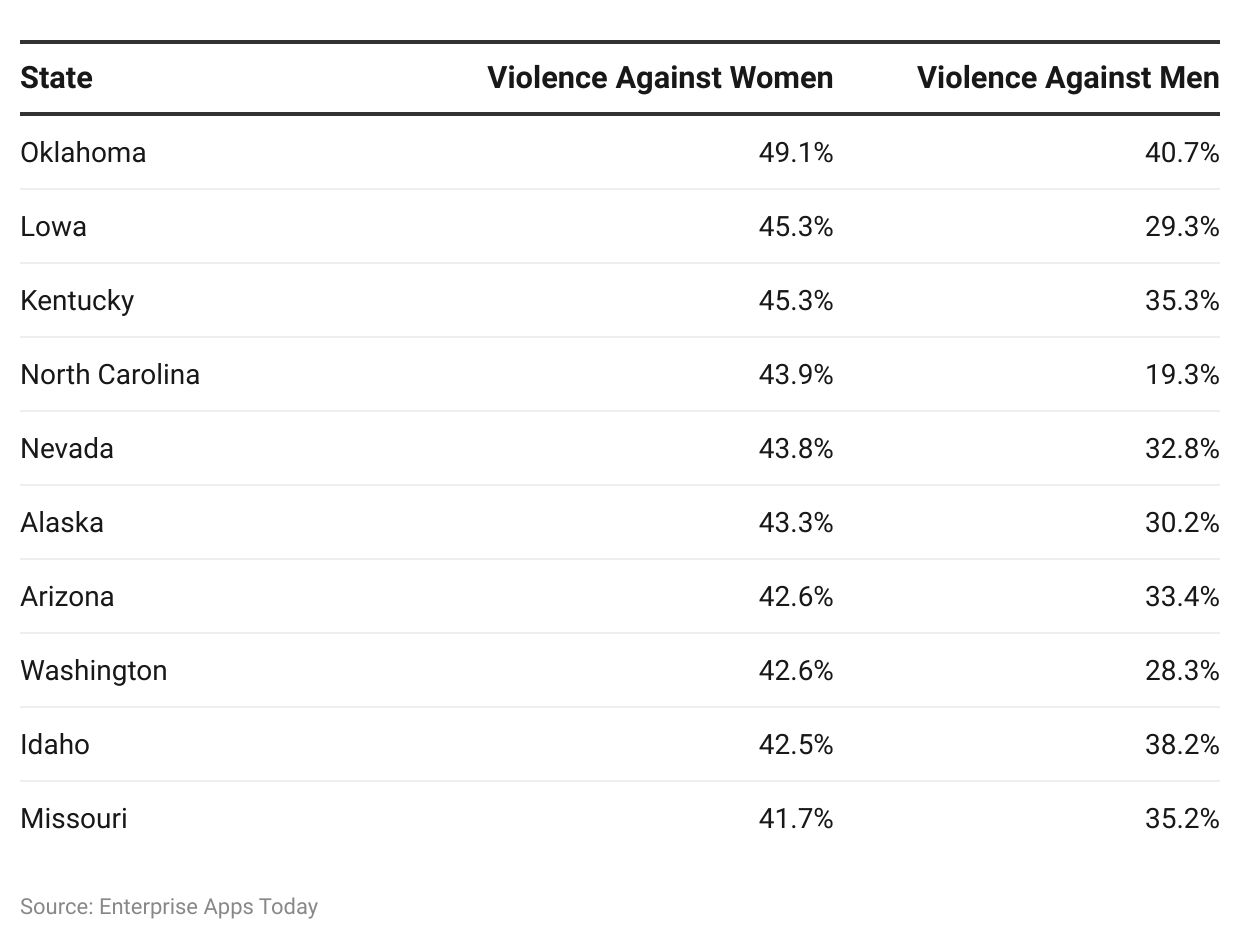
(Reference: worldpopulationreview.com)
- The highest number of violence against women and men is observed in the following states of the United States of America as stated by Domestic Violence Statistics 2023.
- Oklahoma: women 49.1% and men 40.7%, Iowa: women 45.3% and men 29.3%, Kentucky: women 45.3% and men 35.5%, North Carolina: women 43.9% and men 19.3%, Nevada: women 43.8% and men 32.8%, Alaska: women 43.3% and men 30.2%, Arizona: women 42.6% and men 33.4%, Washington: women 42.6% and men 28.3%, Idaho: women 42.5% and men 38.2%, and Missouri: women 41.7% and men 35.2%.
By Lowest
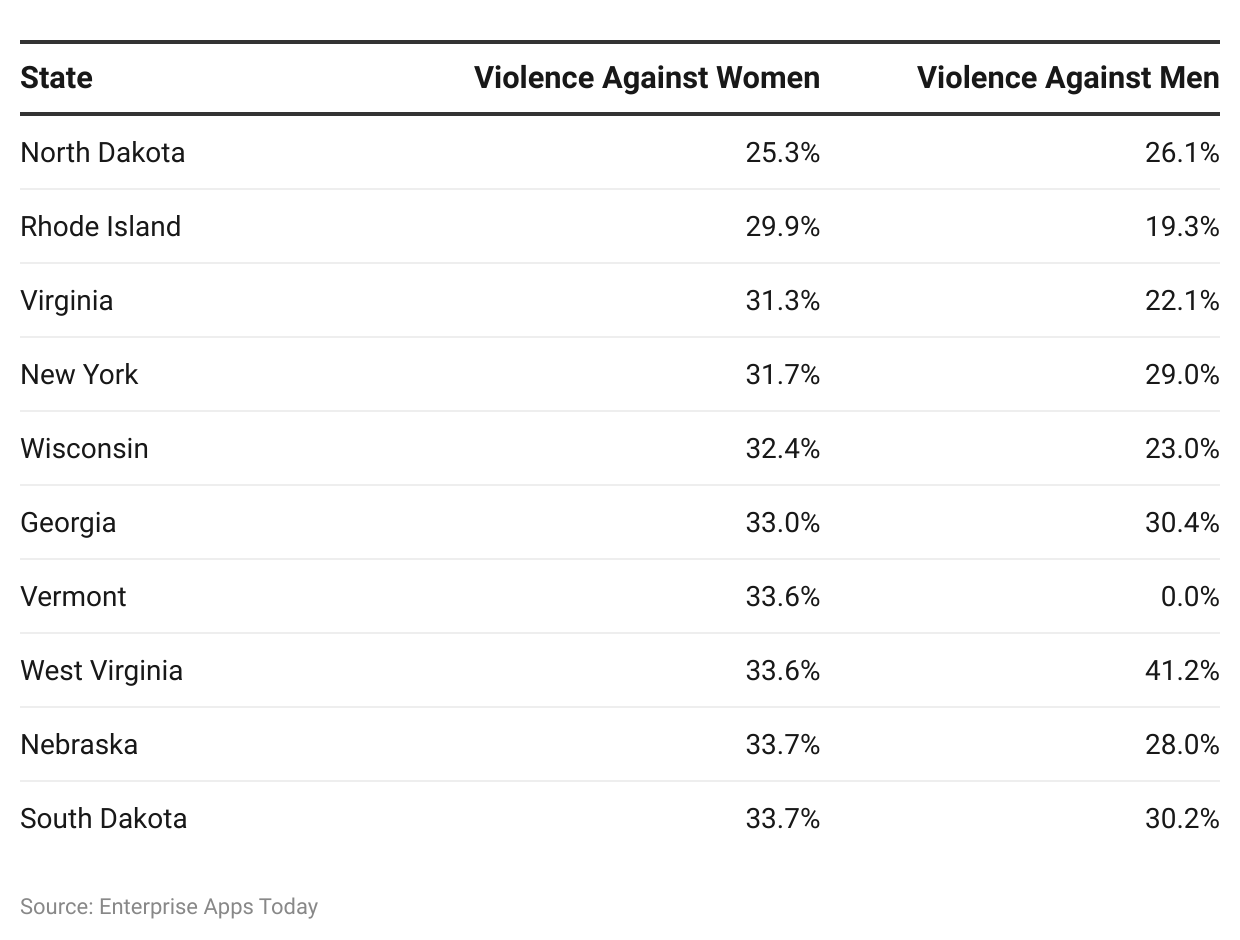 (Reference: worldpopulationreview.com)
(Reference: worldpopulationreview.com)
- The reported lowest domestic abuse rate against women and men in North Dakota resulted in 25.3% and 26.15% respectively.
- Rhode Island has 29.9% against women and 19.3% against men.
- Other states in the United States of America as of 2023, are as follows:
- Virginia: women 31.3% and men 22.1%,
- New York: women 31.7% and men 29%,
- Wisconsin: women 32.4% and men 23%,
- Georgia: women 33% and men 30.4%,
- Vermont: women 33.6% and men 0%,
- West Virginia: women 33.6% and men 41.2%,
- Nebraska: women 33.7% and men 28%, and South Dakota: women 33.7% and men 30.2%.
Domestic Violence Statistics By Abuse Rate
As adult
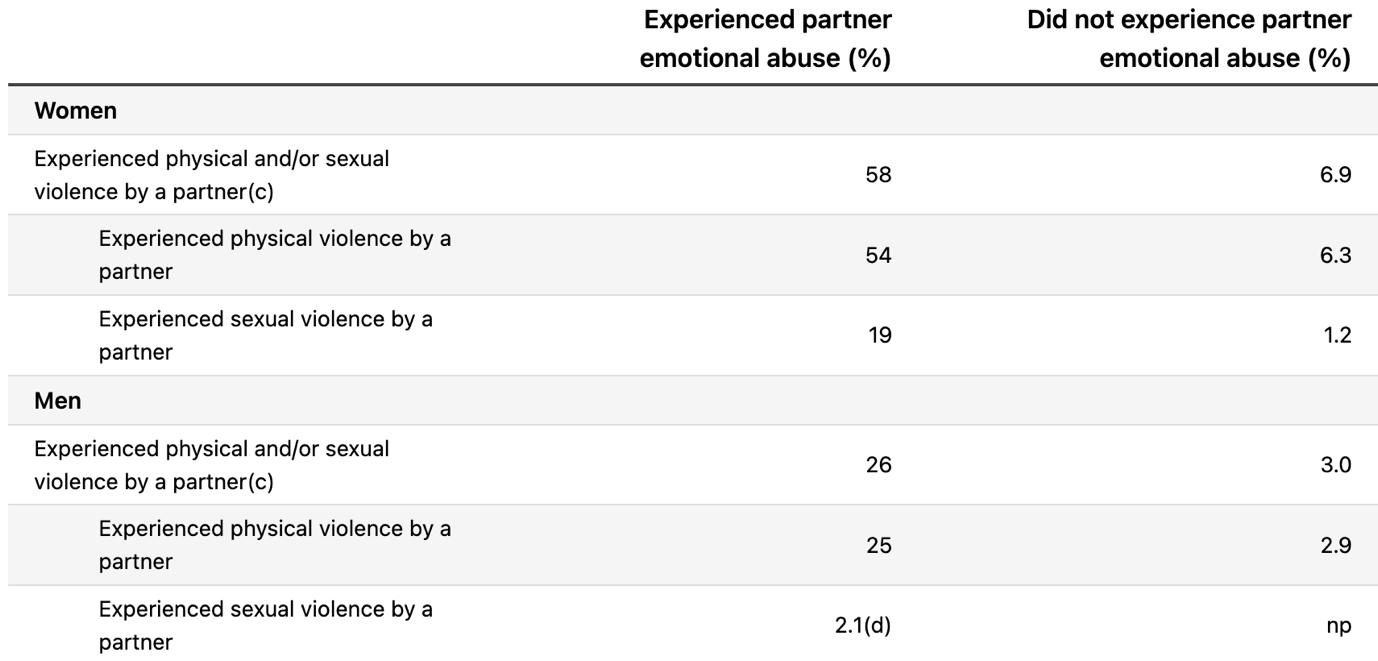 (Source: Australian Bureau of Statistics)
(Source: Australian Bureau of Statistics)
- According to the domestic violence statistics, there are 58% of women faced emotional abuse in terms of physical and sexual violence while 6.9% of women didn’t experience anything.
- On the other hand, 6.3% and 1.2% of women neither experienced any physical nor sexual violence.
- However, 54% of the women faced physical violence by their partner and 19% experienced sexual violence.
- 26% and 3% of men reported the same, out of which 25% faced physical violence and 2.9% didn’t face anything.
- On the other hand, 2.1% experienced sexual violence.
As Child
| Women | Men | |
|---|---|---|
| Experienced physical and/or sexual abuse | 46% | 30% |
| Experienced physical abuse only | 44% | 30% |
| Experienced sexual abuse only | 42% | 27% |
| Experienced both physical and sexual abuse | 57% | 34% |
| Did not experience physical and/or sexual abuse | 18% | 14% |
(Source: Australian Bureau of Statistics)
- According to the reports of Domestic violence statistics, there are only 18% of women and 14% of men have not experienced any physical or sexual abuse.
- The total of women who experienced overall abuse has resulted in 46% while for the men the number is 30%.
- Out of these, 44% of women and 30% of men have only gone through physical abuse.
- Similarly, 42% of women and 27% of men around the globe reported sexual abuse only.
- On the other hand, there are 57% of women and 34% of men faced both physical and sexual abuse.
By Emotional Abuse
 (Source: Australian Bureau of Statistics)
(Source: Australian Bureau of Statistics)
- As of today, there are 9.4 million women and 9 million men aged more than 18 years.
- Out of these, Domestic violence statistics say that 2.2 million women resulting in 23%, and 1.4 million men resulting in 16% have faced emotional abuse from experienced partners.
- 575,400 women and 473,600 men faced problems with their current partners. The overall percentage of respective genders is 6.1% and 5.2%.
- On the other hand, 1.7 million women resulting in 18%, and 1 million men resulting in 12% faced abuse from their previous intimate partner.
- Fortunately, 7.2 million women and 7.6 million men respectively 77% and 84% did not experience any emotional abuse from a partner.
Important Domestic Violence Statistics for 2024
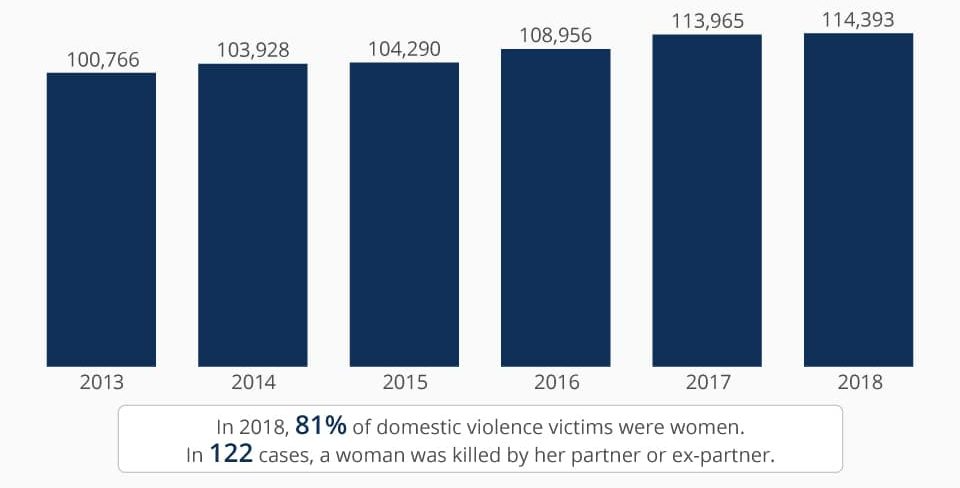
(Source: techreport.com)
#1. One in five victims in Homicide Cases was killed by their partner in love.
In a recent online violent prevention blog, in between 1-5 homicides victims were killed by a partner who was intimate with the victim. These shocking figures also show that their past or current partners killed more than 50 percent of female homicide victims.
#2. 47.3 percent of women and 44.2 Percent of Men reported some form of domestic violence during their lifetime.
A study conducted in 2016/2017 shows there was the United States, 47.3 percent of women have reported different types or forms of domestic violence. This includes sexual assault, physical violence, or emotional harassment, as well as stalking by their domestic partner during their lifetime. These staggering figures suggest that 1 out of two women (59 million) have been victims of this type of. However, the men are afflicted with violence at a rate of 2 out of 5 men this amounts to 44.2 or 52,1 million males. This is a clear indication that violence isn't gender-specific and is an increasing cancer in our society.
#3. Based on the results of the NSVIS survey, 19.6% of Women and 7.6 Percent of Men have had a history of sexual assault from an intimate partner.
The cases of rape as well as sexual assault are among the many of the crimes discovered in this investigation. Additionally, forced penetration is still a part of the sexual contact violence category, and is a serious issue.
#4. Sexual Violence in the Intimate Relationship (IPV) is often a sign of early onset in the early years, before 25.
IPV which is recorded during the adolescent period is known as Teen Dating Violence (TDV). Unfortunately, many teenagers across the United States experience TDC each year. Additionally, around 13 million males as well as 16 million women have reported having TDV before they reached the age of 18.
#5. Over 20,000 calls regarding Domestic Violence are made each Day to United States Authorities.
Domestic violence is still an issue for both individuals and households. The US authorities receive up to 20,000 calls per day on the subject. Additionally, nearly 20 people are physically injured by their partner every moment. The National Coalition Against Domestic Violence declares it as the primary reason for injury to women.
Trends In Domestic Violence
- Increasing Reporting: There's a trend of increasing reporting of domestic violence cases globally, indicating growing awareness and willingness to seek help.
- Technology-Enabled Abuse: With the rise of technology, there's a concerning trend of technology-enabled abuse, such as cyberstalking and harassment, contributing to the complexity of domestic violence cases.
- Impact of Pandemic: The COVID-19 pandemic has exacerbated domestic violence trends, with lockdown measures trapping victims at home with their abusers and leading to a surge in reported cases.
- Intersectionality: There's a growing recognition of the intersectionality of domestic violence, acknowledging that various factors like race, ethnicity, socioeconomic status, and sexual orientation intersect to impact victims' experiences and access to support services.
- Legal Reforms: Many regions are witnessing trends toward legal reforms aimed at strengthening domestic violence laws, providing better protection for victims, and holding perpetrators more accountable.
- Community Support: There's a positive trend towards increased community support for domestic violence survivors, with the establishment of shelters, helplines, and support groups offering assistance and resources.
- Preventive Education: There's a growing trend towards preventive education and awareness campaigns targeting schools, workplaces, and communities to educate individuals about healthy relationships and warning signs of domestic violence.
- Long-Term Effects: Trends also indicate a growing recognition of the long-term effects of domestic violence on survivors' physical and mental health, as well as its broader societal impacts, leading to increased advocacy for comprehensive support services and prevention initiatives.
Recent Developments in Domestic Violence
- Digital Support Services: Recent developments include the introduction of digital support services such as online counseling, chat hotlines, and mobile apps, providing victims with easier access to help and resources.
- Legislative Reforms: Many regions have seen recent legislative reforms aimed at strengthening domestic violence laws, enhancing protections for victims, and imposing stricter penalties on perpetrators.
- Remote Court Proceedings: Due to the COVID-19 pandemic, there's been a shift towards remote court proceedings for domestic violence cases, allowing victims to testify without having to face their abusers in person.
- Corporate Initiatives: Increasingly, corporations are implementing policies and programs to address domestic violence among their employees, offering support services, training, and resources to those affected.
- Tech Innovations: Tech companies are developing innovative solutions to combat domestic violence, such as wearable safety devices, GPS tracking apps, and smart home security systems tailored for victims' safety.
- Awareness Campaigns: Recent developments include the launch of awareness campaigns on social media platforms, television, and other channels to educate the public about domestic violence, raise awareness of available resources, and encourage reporting.
Conclusion
In conclusion, the statistics on domestic violence reveal a deeply concerning reality that impacts millions of individuals worldwide. With approximately 38% of women's deaths attributed to murder by intimate partners globally, and an estimated $3.6 trillion lifetime economic cost of domestic violence in the United States alone, the gravity of the issue cannot be overstated. Recent data also sheds light on the prevalence of domestic violence among specific demographics, with 44.2% of men and 47.3% of women experiencing domestic violence, and 45 million children witnessing family violence during their childhood.
Despite the alarming figures, recent developments offer glimpses of progress in addressing this pervasive problem. Innovations in technology, legislative reforms, and the expansion of support services signal a growing awareness and commitment to combating domestic violence. However, challenges persist, including underreporting, stigma, and the disproportionate impact on marginalized communities.
It's imperative to advocate for evidence-based policies, increased funding for support services, and comprehensive prevention strategies to effectively address domestic violence. By continuing to monitor trends, raise awareness, and advocate for change, we can work towards a future where everyone feels safe and empowered in their homes and relationships.
Sources
FAQ.
You can report domestic violence near your designated police station.
Bruises, isolation, threats, and fear are some of the signs of domestic violence.
You should ask the person to stay away from the house, report it to the police and offer your support by all means.
Yes. You must report domestic violence irrespective of gender, ethnic background, age, or sexuality. Your reported case is always kept confidential, and no harm will be done to you.

By conducting scientific research, I write about illness, health and healthcare. As a professional medical writer, my experience includes creating feature articles for newsletters and websites as well as research news stories for doctors and researchers. Reading has been an integral part of me since childhood - I'm fan of "Friends" and the "Harry Potter series". Before this career, I was employed by a French multinational company. However, my passion for reading led me to pursue writing professionally; my first Amazon-published short story entitled "The envelope that changed our lives" has recently been released. In my free moments, I enjoy long bike rides around town.